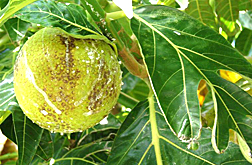This page has been archived and is being provided for reference purposes only. The page is no longer being updated, and therefore, links on the page may be invalid.
| Read the magazine story to find out more. |
|
|
Studies Confirm Breadfruit's Ability to Repel Insects
By Sandra AvantNovember 15, 2013
Breadfruit, used as a folk remedy in Pacific regions to control insects, is an effective mosquito repellent, U.S. Department of Agriculture (USDA) scientists have found.
Agricultural Research Service (ARS) scientists and their collaborators at the University of British Columbia in Okanagan, Canada, identified three breadfruit compounds—capric, undecanoic and lauric acids—that act as insect repellents. ARS is the chief intramural scientific research agency of USDA.
In the study, chemist Charles Cantrell and his colleagues at the ARS Natural Products Utilization Research Unit (NPURU) in Oxford, Miss., and the University of British Columbia scientists collected smoke extracts by burning sun-dried clusters of flowers in the traditional method used by people in Pacific regions.
Capric, undecanoic and lauric acids, which are saturated fatty acids, were found to be significantly more effective at repelling mosquitoes than DEET, the primary insect repellent used against biting insects. For the first time, breadfruit was shown to actually work as a repellent, confirming it as a valid folk remedy, according to Cantrell.
These same compounds found in breadfruit and other folk remedies were shown to be highly active and the most repelling in a different study that examined a variety of saturated and unsaturated fatty acids. Cantrell teamed with Uli Bernier, a chemist in the Mosquito and Fly Research Unit at the ARS Center for Medical, Agricultural and Veterinary Entomology in Gainesville, Fla., and scientists at the University of Mississippi to evaluate the compounds. The test involved cloth treated with different concentrations of compounds and worn by volunteers. Again, these compounds were shown to provide effective protection against mosquitoes.
Funding for these studies was provided in part by the Deployed War-Fighter Protection Research Program. The program focuses on developing public health insecticides and improving technologies to protect U.S. military personnel from disease-transmitting insects such as mosquitoes that spread serious and deadly diseases including malaria, yellow fever and dengue fever.
Read more about this research in the November/December 2013 issue of Agricultural Research magazine.

